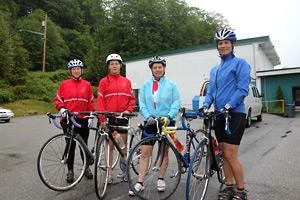A group of cyclists arrived at Henderson Elementary School on the morning of Thursday, June 2 to speak to students about Type 2 diabetes and the sugar content of pop.
Robin Nadig, team leader and organizer, said this is the ninth time the Kiwanis Cycles Kilometres for Diabetes team has come to Powell River on one of these trips, this time bringing with it six cyclists. Nadig organizes the event because she believes in the cause and enjoys working with students in promoting a healthy lifestyle. The initiative has raised close to $100,000 over the past eight years through pledges and donations.
“Basically, I just wanted to start something where we could help young kids [and promote] healthy eating and an active lifestyle,” said Nadig. “Because it’s preventable it’s somewhere we want to go and lead by example.”
The group started out in Oak Bay the previous Sunday and finished the trip off in Port Alberni on Friday, June 3, six days and 450 kilometres later. They made stops in Duncan, Nanaimo and Courtenay along the way, visiting schools and making their presentation on the ever-growing problem of diabetes in children.
Once considered to be an adult problem, the Canadian Diabetes Association reports there has been a 10- to 30-fold increase in American children with the disease in the past 10 to 15 years. They also report that experts anticipate a 50-per-cent increase of the global incidence of Type 2 diabetes in children over the next 15 years.
Nadig said the most frustrating thing about these numbers is that the condition is, for the most part, largely preventable. That’s why she and her fellow cyclists are talking to students about being active and reducing the amount of sugar in their diets, which can contribute to the onset of the condition.
This year the focus of the group is soda pop and other sweet beverages, which can carry as much as 13 teaspoons of sugar in one can. To illustrate their point the group shows the students plastic bags filled with the amount of sugar found in different sizes of pop. Nadig said most students are amazed to see just how much sugar can be found in one can of pop and especially in a large convenience store fountain pop, which can contain up to 32 teaspoons of sugar.
“It’s like swallowing a bowl of sugar,” said Nadig. “It’s just one small thing to eliminate.”



